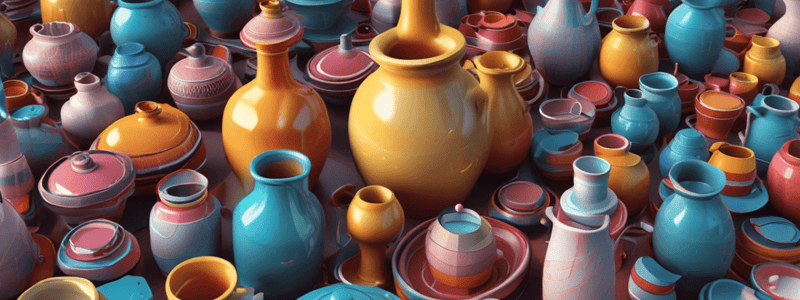Podcast
Questions and Answers
How is the ice in freeze casting treated to produce porous ceramic pre-forms?
How is the ice in freeze casting treated to produce porous ceramic pre-forms?
- Mixed with plastic forming clay
- Allowed to sublimate at low pressure (correct)
- Heated to high temperature
- Melted and poured into molds
What is the purpose of physical vapour deposition (PVD) in relation to ceramics?
What is the purpose of physical vapour deposition (PVD) in relation to ceramics?
- To create thick coatings
- To achieve low porosity and a refined surface finish (correct)
- To make ceramics resistant to high temperatures
- To increase porosity
How are ceramic coatings applied using plasma spraying?
How are ceramic coatings applied using plasma spraying?
- By mixing with plastic forming clay
- By feeding ceramic powder through plasma created by passing an electric arc (correct)
- By heating and melting the ceramics
- By evaporating the ceramics in a vacuum
What method allows for the production of highly porous ceramics suitable for filters and catalysts?
What method allows for the production of highly porous ceramics suitable for filters and catalysts?
What happens to ceramic powder during physical vapour deposition (PVD)?
What happens to ceramic powder during physical vapour deposition (PVD)?
What method is effective for reducing porosity in products made using additive manufacturing techniques?
What method is effective for reducing porosity in products made using additive manufacturing techniques?
Which technique involves pouring a ceramic mixture into a plaster mould and leaving behind a viscous layer?
Which technique involves pouring a ceramic mixture into a plaster mould and leaving behind a viscous layer?
What allows the mass production of ceramics with complex relief patterns?
What allows the mass production of ceramics with complex relief patterns?
Which process involves the use of a monomer binder that polymerizes to form a gel binding ceramic particles?
Which process involves the use of a monomer binder that polymerizes to form a gel binding ceramic particles?
Which technique utilizes a suspension of ceramic particles in water for processing?
Which technique utilizes a suspension of ceramic particles in water for processing?
Which process ensures the cohesion of ceramic powder in green parts?
Which process ensures the cohesion of ceramic powder in green parts?
What is the main function of a dispersant when mixed with ceramic powder?
What is the main function of a dispersant when mixed with ceramic powder?
Which stage involves removing the binding agent from technical ceramics?
Which stage involves removing the binding agent from technical ceramics?
What is the purpose of green machining in technical ceramic production?
What is the purpose of green machining in technical ceramic production?
Which process involves adjusting the viscosity of the ceramic mixture?
Which process involves adjusting the viscosity of the ceramic mixture?
What is the main reason for using Titanium nitride (TiN) in various applications?
What is the main reason for using Titanium nitride (TiN) in various applications?
Which material can be formed when clay is fired?
Which material can be formed when clay is fired?
What mineral is commonly found in clay besides Kaolinite?
What mineral is commonly found in clay besides Kaolinite?
What microstructure is largely responsible for the properties of porcelain?
What microstructure is largely responsible for the properties of porcelain?
What kind of coatings can Titanium nitride (TiN) be used for in the industry?
What kind of coatings can Titanium nitride (TiN) be used for in the industry?
What microstructure does mullite form when the processing and composition are right?
What microstructure does mullite form when the processing and composition are right?
Apart from clay, what other materials can be used to produce mullite-containing ceramics?
Apart from clay, what other materials can be used to produce mullite-containing ceramics?
In what specific applications are ALON ceramics predominantly used?
In what specific applications are ALON ceramics predominantly used?
What unique property of SiAlONs makes them phosphorescent in UV light when doped?
What unique property of SiAlONs makes them phosphorescent in UV light when doped?
What outstanding properties do ceramics, as mentioned in the text, possess?
What outstanding properties do ceramics, as mentioned in the text, possess?
Flashcards are hidden until you start studying
Study Notes
- HIP-ing is a method used to reduce porosity in products made through additive manufacturing techniques.
- Slip casting involves pouring a ceramic mixture (slip) into a plaster mold, allowing it to dry, and then removing the ceramic for further processing.
- Tape casting is used to produce thin ceramic tapes or sheets by flowing a ceramic slurry onto a carrier film and adjusting thickness with a doctor blade.
- Gel-casting involves mixing ceramic powder with water and a binder to create a gel that can be used to fill complex molds for precise ceramic forming.
- Freeze casting uses a suspension of ceramic particles in water to create porous ceramic pre-forms for filters, catalysts, and medical applications.
- ALON ceramics are known for high hardness, high melting point, and transparency, widely used in military applications for armor and sensor windows.
- SiAlON ceramics are valued for their hardness, use temperature, chemical stability, and are used in various applications like cutting tools and colored phosphors.
- The processing of technical ceramics involves steps like material preparation, molding, sintering, and finishing, with a focus on quality control throughout the production stages.
Studying That Suits You
Use AI to generate personalized quizzes and flashcards to suit your learning preferences.


